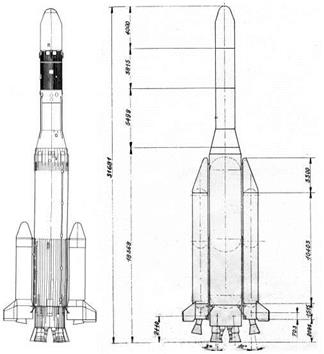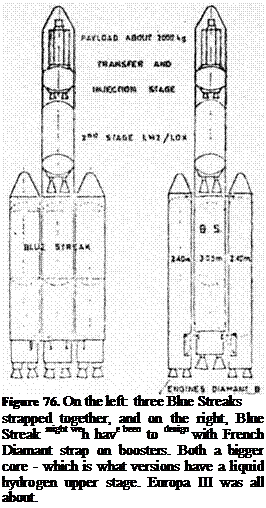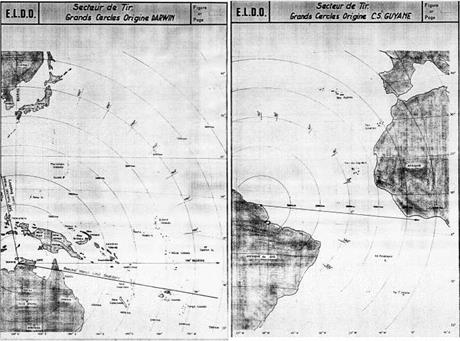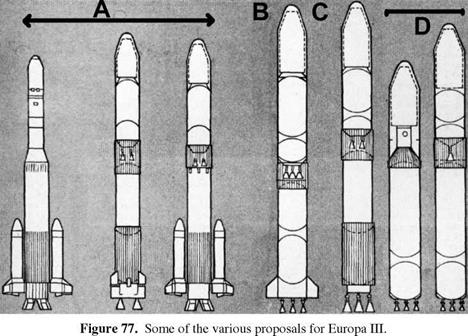Improving Europa
The first geosynchronous communications satellite was Syncom 2, in July 1963 (since the orbit was inclined to the equator, it was not, strictly speaking, geostationary). The first geostationary communications satellite was Syncom 3, launched in August 1964, and used to transmit the 1964 Olympics in Tokyo to the United States.
It was the French who, as early as 1964, realised the limitations of Europa and proposed that it should be dropped in favour of a more powerful design. To be fair, the design had been put together without much of a rationale behind the overall concept other than to produce a satellite launcher, and there had been no clear idea of what satellites it might be launching. Although Europa might be able to put a respectable payload into low earth orbit, there was simply no demand in Europe for such a capability. On the other hand, the French were quick to see the possibilities in communications satellites (unlike the British, who remained sceptical for a long time). ELDO A’s capacity for geostationary orbit was minimal or non-existent.
The French Government’s proposal was to replace the planned upper stages of ELDO A with what were usually referred to as ‘high energy stages’ – in other words, liquid hydrogen. An ELDO review paper of 1964 shows the thinking behind these designs [translated from the original French by the author]:
By 1963, the Secretariat had requested proposals from the member states for the
design of launchers using upper stages with high energy propellants.
The feasibility studies were placed by the Secretariat in November 1963. They
consisted essentially of two types of launchers:
– a launcher ELDO-B whose design used as first stage the Blue Streak of the Initial Programme. This launcher should be able to place at least 2 tonnes in low orbit and, with an apogee motor, at least 500kg in a synchronous orbit.
–  a launcher ELDO-C which had been defined by its performance (6 to 10 tonnes in low orbit – 1.7 tonnes to escape velocity).
a launcher ELDO-C which had been defined by its performance (6 to 10 tonnes in low orbit – 1.7 tonnes to escape velocity).
The reports corresponding to these studies have been studied by the Secretariat. Work complementary to these studies on these launchers has also been undertaken.
As a consequence, a general line of conduct can now be shown, which is based on the following principles:
1) using liquid hydrogen/oxygen gives advantages which can be seen from many points of view (high performance at a relatively modest cost, experience already acquired, function proved by launchers in the USA etc.)
2) an economic way of using this propulsion in different high energy stages by using one motor which can be grouped together and most importantly can follow the dimensions of the stages in question…
Whatever the choice of definitive designs for the launcher ELDO B, it appears that it is now possible to envisage beginning development work by the start of 1965.
This would involve. the development of a motor: it seems that a motor of thrust of 6 to 7 tonnes would be optimal… It is therefore the intention of the Secretariat to place in very general terms, within the body of the budget of the Future Programme 1964, three contracts for the study of such a motor; the development could begin, after the choice of the best design, at the start of 1965.6
One of the contracts issued was to Rolls Royce, who then developed the RZ 20 motor, intended for the upper stages of ELDO B.7
There were in effect two proposed designs which were closely linked: B1 and B2. The third design, ELDO C, was much sketchier.
B1 would have one upper stage, B2 would have two. Each of the stages would use the same rocket motor – as mentioned above, with a thrust of 6-7 tonnes (60-70 kN, or around 14,000 lb). By comparison, the American Centaur stage, first attempted launch 1962, had two motors each of 15,000 lb thrust. The B1 stage
would have one of these motors, the B2 stage would have four such motors, and the B1 stage would be the third stage of the B2 design.
One problem was the large volume which liquid hydrogen occupies. This meant that the relatively light B1 stage was almost the same length of the first stage, and to assist aerodynamic stability at low speeds just after lift-off, it was proposed to fit four fins onto the kerosene tank of Blue Streak, although this idea only appears in early sketches for ELDO B. Another was that the maximum weight Blue Streak could carry in the form of upper stages was limited by the first stage thrust to 16,100 kg, and the extra weight on top of the vehicle meant that the stresses were greater so that thicker gauge stainless steel would be needed, making the first stage heavier.
ELDO B2 meant pushing Blue Streak to its limit – and perhaps beyond! The weight of the upper stages meant that the launcher would only be possible if the RZ 2 motor were uprated from 150,000 lb thrust to 165,000 lb, and the resultant vehicle would have a lift off acceleration of only 0.25 g. This implies a lift-off weight of the order of 265,000 lb. It would also mean strengthening the liquid oxygen tank by increasing the skin thickness from 0.6 mm to 1.5 mm, with a weight penalty of 0.85 tons. (Another solution was, of course, the strap-on boosters already described.)
The French failed to gather enough support from the other member states to switch the programme from Europa to ELDO B: at the Intergovernmental Conference in July 1966, a five-year revised programme for ELDO A and PAS vehicles was agreed; the B1 and B2 launchers were effectively abandoned at the same conference.
A little money was still available for ‘studies’. In the following years, different firms produced a plethora of designs for an ELDO B launcher, some not much more than sketches, others fully worked out designs, but as a consequence of the intransigence of the British Government, none of these were to come to fruition. However, they were to appear once again when studies began for a Europa III.
For a variety of reasons, opposition to ELDO B was led by the UK. Firstly, the new Wilson Government were against ELDO in itself; the last thing they and the Treasury wanted was an open-ended commitment to further spending. Secondly, it did not share the French view that the future lay in communications satellites, and moreover, even if it did, it was not convinced that there would be sufficient demand for a second, competing system. Thirdly, it did not believe that it would be ‘economic’ in the sense that the United States could always undercut ELDO in price. (There is a further discussion about this in the section about the Treasury.)
There was a fourth factor too: the UK had no inherent objection to using American launchers (the early military Skynet satellites were launched using Delta and Titan launchers, although later ones have used Ariane 4 and Ariane 5). The French, on the other hand, were very resistant to the idea of relying on the United States. In particular, they were wary of the restrictions that might be placed on competing commercial systems.
There was one other requirement if Europa was to be used to launch communications satellites: a new launch site. Firstly, whatever site was chosen would have to be as close to the equator as possible – unless the satellite is in an equatorial orbit, it will appear to ‘wander’ north and south in the sky. Secondly, communications satellites need to be launched in an easterly direction to take advantage of the spin of the Earth. The difference this makes is quite considerable: the speed of rotation of the Earth at the equator is close to half a kilometre a second. A clear launch corridor is also needed: the first stage of the satellite launcher will fall to the ground not that far from the launch site, and if the flight has to be terminated for any reason, or the launcher explodes, then the debris cannot be allowed to fall on populated areas. Woomera had very restricted launch corridors, which were mainly in a northerly direction. As a range for testing rockets and missiles, Woomera was ideal, but it had considerable geographical limitations as a satellite launching base.
Effectively then the site had to be on the eastern seaboard of a large ocean, where spent stages could fall without hazard (except to passing shipping!). ELDO considered several sites, although only two were serious contenders. One was the Australian proposal of Darwin in northern Australia, and the other was the French proposal of Kourou in French Guiana, an overseas region and departement of France located in South America. The choice fell on Kourou, which is now used for the Ariane launchers. Darwin was ruled out on various counts. One was that it was technically inadequate (this seems rather odd – the infrastructure at Kourou cannot have been very advanced at that stage), from the safety angle as being too heavily populated, and cost – which again seems a little odd. Woomera had cost ELDO nothing as it was being provided by the Australians, and it might well be expected that Australia would pay for a large part of the new site. One valid technical point was that it was further from the equator (12°S as opposed to 5°N).
The impression here and elsewhere is that the French are in the driving seat, and that choices were often made for political reasons, with technical reasons coming second (and the reasoning often questionable: would northern Australia be ‘technically inadequate’ compared with the South American jungle?). The new vehicle was given the title of Europa II, although the changes were fairly
|
Figure 74. ‘Arcs of fire’ from Darwin and from Kourou. |
minimal. The British objected to even this fairly modest proposal on the grounds that the PAS system was not part of the ‘original programme’. This was a mantra that the British Government would produce time and again.
Even so, 170 kg was not a particularly substantial payload for a communications satellite. To be of much use, this would have to be increased, and one cheap and easy way of doing this was to add strap-on boosters.
Indeed, as early as January 1963 the Italians came up with a proposal for 10 ft diameter solid fuel motors to be strapped on to Blue Streak, rather in the style of Titan III. The proposal was passed through to RAE, where Harold Robinson thought some of the assumptions rather optimistic.8 The Italians thought the combination could put 10 tons into orbit; Robinson was more pessimistic at 6.25 tons. Making motors this size with no prior experience would have been a considerable challenge, and in addition, Blue Streak would have to be strengthened quite considerably to take such a load.9
Since the French were now the leading lights in ELDO, it was inevitable that most of the proposals for uprating the launcher would come from them. Of the
many proposals made to improve Europa, the most significant from French companies such as SEREB (Societe pour l’Etude et la Realisation d’Engins Balistiques). One such proposal used P16 solid fuel boosters (P for French poudre, early solid fuel rockets being made from gunpowder) derived from the first stage of the French silo-based ballistic missile. The L17 liquid fuel boosters derived from the Diamant satellite launcher.
|
Figure 75. On the left is Europa with the French P16 boosters. Drawn on the right is the version with French L17 boosters.
|

modern communications satellite. On the other hand, only two boosters are being considered. Ariane had a ‘pick and mix’ approach to boosters, with two or four solid or liquid boosters. Four boosters would certainly increase the payload a good deal further – and give the opportunity to stretch the upper stages at the same time.
Even larger boosters were being considered, as this talk by Dr K Iserland of ELDO in 1968, given to the Royal Aeronautical Society, shows:
… on the other hand, the use of liquid boosters is also being studied, and, in particular, two practical solutions – one based on Blue Streak, in other words using two Blue Streaks as additional boosters, and the other based on the technique of Diamant B, using the first stage of the improved version of the French Diamant B
 launcher… in the first case three Blue Streaks are attached together side by side and they would all be lit up together from the start. Propellant would be pumped continuously from the outer boosters to the engine of the central Blue Streak so that, at booster jettisoning, the central or core stage is still full and continues to burn for a full burning time. The version deriving from Diamant B type uses four boosters clustered around the central Blue Streak. They each have a diameter of 2.4 m, as compared with the 3 m of Blue Streak, and have 4 engines of 36 tonnes thrust each. The outer four boosters are functioning as a zero stage… i. e., the core stage is lit up at the end of the booster phase only.
launcher… in the first case three Blue Streaks are attached together side by side and they would all be lit up together from the start. Propellant would be pumped continuously from the outer boosters to the engine of the central Blue Streak so that, at booster jettisoning, the central or core stage is still full and continues to burn for a full burning time. The version deriving from Diamant B type uses four boosters clustered around the central Blue Streak. They each have a diameter of 2.4 m, as compared with the 3 m of Blue Streak, and have 4 engines of 36 tonnes thrust each. The outer four boosters are functioning as a zero stage… i. e., the core stage is lit up at the end of the booster phase only.
It might be said that having to resort to these rather extreme measures points up the inadequacy of Blue Streak as the main core. A better approach
In December 1969, an ELDO report outlined various feasibility studies for a Europa III design10. It was stipulated that the new vehicle should have the capacity to launch 400-700 kg into geostationary orbit, and a brief history of previous proposals was outlined – the most significant of which had been made in 1969, when there was a proposal to replace Blue Streak with a French designed first stage designated the L135, which burned N2O4/UDMH. It would have a diameter greater than 3 m and the capacity to put a payload of 600 kg into geostationary orbit.
The report also thought that the proposal to uprate Europa II with boosters for relatively low cost to give around a 280 kg geostationary payload would not meet the payload criterion. A new booster would be needed, and four possibilities for the first stage were then considered (in the context of this discussion, ‘high energy’ can be read to mean ‘liquid hydrogen’).
A: This would be based around Blue Streak with a high energy stage, which would have been capable of putting 500 kg into geostationary orbit. The problem was that this design lay at the lower end of the performance spectrum.
With strap-on boosters, the payload was increased to 750-800 kg, but there were two drawbacks: firstly, that the design had been stretched as far as it would go and so no further development was possible; and second, that the 3 m diameter of the stage was thought to be a disadvantage.
There was also the consideration of the availability of Blue Streak after 1976 given the British Government’s attitude to ELDO – although no doubt Rolls Royce and HSD could have produced them easily enough on a commercial basis. The running costs of Spadeadam might also have been a problem, since it was currently being funded by Britain.
B: this was based on the French L135 design already mentioned, with a diameter of 3.6 m, and a capability of launching 700-750 kg to geostationary orbit.
C: the first stage would have been powered by four RZ 2 chambers, downrated back to 137,000 lb (it is not made clear why the downrating was thought to have been a good idea). It was thought that this vehicle was capable of 850-900kg to geostationary orbit. The report shows a distinct lack of enthusiasm for the design, with the comment that Europe was ‘more experienced in N2O4/UDMH technology than in lox/kerosene’. This is an odd comment, since liquid oxygen/kerosene is hardly the most sophisticated of technologies, and the motors were to be provided by Rolls Royce, which did have a fair amount of experience in the technology. It was probably the political dimension which ruled this design out – the main motors for the vehicle would have been produced in a country which was not a member, and which had done its best to wreck the organisation! The tank structure would have been light alloy rather than the stainless steel balloon design of Blue Streak.
The timescale for each of these three designs would be set by the high energy upper stage – that is, the liquid hydrogen upper stage.
D: this was an all hydrogen design, which looked distinctly aspirational – in other words, whereas engineers might relish the challenge of producing such a design; politically and economically it represented a distinct challenge.
The estimated cost of each design (in MMU) was:
|
A |
B |
C |
D |
|
641* |
770 |
747 |
852 |
|
629** * with solid boosters |
** with liquid boosters |
|
MMU = Million Monetary Units, the notional currency of ELDO, effectively equivalent to one American dollar. 1 MU = £0.413 |
On the other hand, given the speculative nature of most of these designs, any attempt to cost them seems distinctly futile. They are probably in the right order, but that is about as much as can be said for them..
The conclusion of the report ran roughly as follows. Option A was viable only if cost were a consideration. B represents the best compromise – although, again, it was not made clear what the compromise was. C matched the performance criterion but ‘represents from the engineering standpoint a compromise with the EUROPA I and II vehicle system’. This is another fairly political point, since the only part of Europa that had worked without fault on every flight was the RZ 2 motor, and that was the only point of commonality. As for D – it was acknowledged that the design was not very realistic at the present time.
Despite these figures, the report of EUROPA II AD HOC group in May 1972 came to very different conclusions. (The ‘low cost configurations’ being referred to are upgrades of Europa, or option A in the previous report.)
The EUROPA II ad hoc group concludes that, even without making provision for additional development launchings, the low cost configurations will most probably not result in a significant saving with respect to EUROPA II; if provision is made for additional firings – the necessity of which is accepted, except by the German delegation – all low cost launchers will be more expensive than EUROPA III.
|
The ad hoc group notes that the low cost launchers do not have the same growth potential as the EUROPA III launcher whose performance increase would be more cost effective. Under the circumstances, the majority of the EUROPA II ad hoc group cannot recommend further study of the so-called low cost configurations.11 |
Whether or not Blue Streak-based options were technically adequate or financially viable, there is a very strong likelihood that they would be politically unacceptable, given the past attitude of the UK Government.
As is well known, option B was chosen, and after further evolution of the design, went on to become Ariane I – but that is another story.
More interesting from the British point of view was option C. Unlike Blue Streak, it would have light alloy tanks rather than stainless steel, but still with stringers to the kerosene tank (it was not made clear why stringers would be needed with conventional tanks). The main stage motor would have four RZ 2 Mk III engines each of 62.2 tonnes (137,000 lb) thrust, with the ability to swivel in the tangential plane only (this feature might have been borrowed from the Gamma 201 of Black Knight). Quite why the thrust had been down rated from
150,0 lb back to the original 137,000 lb was also not made clear.
The estimated cost of the new motor was £7,536,500 (18.1 MMU), and the annual cost of running Spadeadam was put at 2.25 MMU. There would be a completely open engine bay, 3.6 m diameter, with each motor having a separate pump and turbine.12
Val Cleaver of Rolls Royce produced the brochure, which he sent with a covering letter. The letter did not display a great deal of enthusiasm for the proposition, describing the RZ 2 as ‘1950s technology’, and hinting strongly that a motor using high energy propellants would be far more interesting. Cleaver might have been a good engineer, but he was obviously not so good as a salesman! Whatever his feelings about being asked to produce a design of that sort, he might have done better to keep them to himself.
The ironic part of the story is that a four engined RZ 2 first stage would have almost certainly have been cheaper to develop than the L135 design which became Ariane and would have kept the UK in the launcher business. With any luck, it could have been as successful as Ariane was. Unfortunately, the British Government was actively hostile to the idea of a new launcher, and the new design was effectively a French vehicle. Thus ELDO died, and Ariane was born. [13] [14]












